
The History of H M Schooner PICKLE
The fabulous replica of Nelson’s topsail schooner HM Schooner Pickle that featured in the BBC series Boats that Built Britain has
been bought by MNABC member Mal Nicholson, owner of the magnificent Humber sloop Spider T.
The original PICKLE was a schooner. So any reference to her as HMS PICKLE or any description of her as a ship is historically
completely wrong. In 1805 terms a ship was a three masted, square-rigged vessel, and a naval ‘Ship’ (with a capital S) was under
the command of a Captain RN. The PICKLE was neither.
In 1800 Vice Admiral Lord Hugh Seymour, Commander-in-Chief at Jamaica, wrote
to the Navy Board in London to inform them that he wished to purchase a new
schooner to act as tender to his flagship HMS SANS PAREIL. The Navy Board
wrote back ordering him to do no such thing, but Lord Hugh was son of the Marquis
of Hertford, grandson of the Duke of Conway, son-in-law of the Marquis of
Waldegrave and the Duchess of Gloucester, friend of the Prince of Wales, MP for
Portsmouth and a former Lord Commissioner of the and he was not about to be told
what to do by some bean-counting civil servant. So his next letter to the Navy
Board in December 1800 described their newly purchased tender, the STING, a
‘clever, fast-sailing schooner of about 125 tons, coppered and in every respect
suited for the service’, cost just £2500. She measured 73 ft. overall, 56 ft. 3 in. on
the keel, by 20 ft. 7 in breadth and 9ft 6in depth, giving a measurement of 127 tons.
For naval service she was armed with six carronades, 12 or 18 pounders, and had
a complement of 35 to 40. She was built in 1799, probably at Bermuda, for a
consortium of Jamaica merchants, perhaps (given her name) with the intention of
using her as a privateer.
Lieutenant Thomas Thrush of the flagship SANS PAREIL was given command of
the STING, and her first year of service in the Caribbean was as squadron
despatch vessel, carrying despatches, orders, stores and personnel to the station's
outlying ships and establishments. The Navy Board had ordered that the STING
should be renamed PICKLE, but throughout her time in the West Indies this order was ignored. The reason for the order was
probably not to keep the illustrious name PICKLE alive but to disguise the acquisition of a new schooner from the Royal Navy’s oldest
and most bitter enemy, the Treasury.
In September 1801 Lord Hugh Seymour died of yellow fever. Naturally, his family and connections wanted him to be buried at home
in England, so the STING, Lieutenant Thomas Thrush commanding, first formally opened a Pay Book as an independent command in
October 1801, to carry the Admiral’s body home to England.
In May 1802 Lt Thrush was relieved by the PICKLE's new commander, Lt John Richards Lapenotiere. Under Lapenotiere's
command, she was initially employed in the Mediterranean carrying despatches to Sir Richard Bickerton's squadron off Sardinia, with
visits to Naples, Malta, Cartagena and Gibraltar. In 1803 she joined the fleet off Ushant, for the close blockade of the French naval
base at Brest and the Brest Blockade was the PICKLE's station for the next year and a half, with occasional diversions carrying
despatches to the squadrons off Ferrol, Corunna and Rochfort. The PICKLE, as one of Admiral Comwallis' s fleet's smallest vessels,
was usually given the dogsbody jobs and was horribly hard worked. She had been built for speed, and for the Caribbean not for
inshore, all-weather, work in whatever the English Channel could throw at her.
During Lapenotiere' s 41 months in command of the PICKLE she lost or sprung her bowsprit or jibboom seven times, as well as
losing or damaging other spars, including her main boom three times. On three occasions he had to heave some of the schooner's
guns overboard to save the ship. None of her other commanding officers ever managed to suffer damage or loss at anything like that
rate.
The PICKLE was sent to the West Indies over the winter of 1804/05, returning to Plymouth for a long refit in May 1805. Between July
and October she shuttled between Plymouth, Sir Robert Calder's fleet off Finisterre and Lord Nelson's off Cadiz, carrying despatches,
narrowly avoiding capture by Spanish gunboats on one occasion. In early October she was off Cadiz with Henry Blackwood's
Advanced Squadron of frigates when, early on the 19
th
, the Combined Fleet at last came out. During the battle of Trafalgar, two
days later, PICKLE's task was to act as 'safety boat’, rescuing swimmers and doing what good she could where she could. (The
frigates, brigs, schooners and cutters of both opposing fleets did not take an active, shooting, role in a fleet action between line-of-
battle ships.). Most notably she and her boats together with the boats of the other unengaged ships, saved many men and one
woman, Jeanne Caunant, from the sea when the French ship ACHILLE caught fire and blew up. By the time the fighting was over,
the PICKLE had somehow managed to find room for 160 French prisoners, all survivors of the ACHILLE.
On the 26
th
Lt Lapenotiere was summoned on board HMS EURYALUS, Admiral Collingwood's temporary flagship, to be given the
prize job of taking news of the victory - and of Nelson's death - home to the Admiralty. For Lapenotiere this was the career defining
moment. He was 35 years old, and although he had a command, it was only a schooner - for years he had been the fleet's SLJO
('silly' little jobs officer) and without a lucky break he could expect no further promotion, or much future employment. Now, whoever
carried this news home was sure of promotion to Commander and a sloop to command; he could also look forward to a sizeable cash
reward - £500 was the going rate for bringing news of a victory in a fleet action. He would also be a little famous at least for a while
(he's managed 200 years so far). Normally, this sort of plum would have gone to a frigate Captain, in this instance probably
Blackwood of the EURYALUS, but Collingwood needed every ship of force by him in case of another attempt by the survivors of the
Combined Fleet to break out.
At noon on the 26
th
the PICKLE shaped her course for England. On the 29
th
, with Cape St Vincent in sight over the starboard
quarter, all Lapenotiere's dreams turned to ashes, as HM Sloop NAUTILUS joined company. Her captain, Commander John Sykes,
came on board, learned the news and, rather officiously (but certainly correctly, being the senior officer), offered to share the burden
of carrying it. NAUTILUS then set a course for Plymouth and, being the bigger vessel, square rigged and a better sea-boat in that
following wind and swell than the PICKLE, within a couple of days had, caught her, overhauled her, and passed out of sight over the
horizon. It was all going horribly wrong for the PICKLE and Lt Lapenotiere, and they must have thought the race was already lost. But
never say die.
On the 2
nd
of November, the NAUTILUS was very nearly intercepted by a French squadron out of Lorient though they made no effort
to chase. The PICKLE, from being far behind, was now over the horizon and far ahead. At 10am on the 4
th
of November,
Lapenotiere went ashore at Fish Strand Quay, Falmouth, announced the news to the few spectators and hired a post chaise to take
him the 266 miles to London. This was a huge gamble, and a huge investment - the cost to hire a four horse shay from Falmouth to
London was half a Lieutenant’s annual pay and he had no guarantee the Admiralty's travel budget would reimburse him. But the
normal coach service would have taken a week or so, Collingwood's despatches contained the most important news in a generation
and he still didn't know whether he was running second to Sykes of the NAUTILUS.
In fact the NAUTILUS was half a day behind, and heading for Plymouth, forty miles further East. Sykes landed at Plymouth late in the
evening of the 4
th
, and then he too took a post chaise up to London, but Lapenotiere was still ahead. Lapenotiere eventually reached
the Admiralty, 19 changes of horses and 37 hours after leaving Falmouth, not long before midnight on 6
th
November. The Secretary of
the Admiralty, William Marsden, had been working late (as usual), and met Lapenotiere in the Boardroom. “Sir, we have gained a
great victory, but we have lost Lord Nelson”. The First Lord, Lord Barham, and his domestic staff had turned in, and it took Marsden
some time to find him. When he shook him awake, Barham's first words were “What news, Mr. M?”. Then the two men set-to to
compose letters to spread the news to the Cabinet, the King and the Lord Mayor of London. They also had to prepare Collingwood’s
despatches for publication, first in the London Gazette, the official Government journal, then for the public presses. While this was
going on, Sykes's post chaise pulled in to the Yard of the Admiralty - just about an hour too late.
In the morning Lapenotiere was taken to Windsor where he explained the progress of the battle to King George using the breakfast
cutlery to show the movements of the opposing fleets - Nelson's flagship HMS VICTORY was represented by a silver muffmiere
(whatever that is), which the King, in an act of charming eccentricity, insisted on presenting to Lapenotiere.
In addition to this, and perhaps more significantly to him, Lapenotiere was promoted to Commander, received a sword worth 100
guineas from the Patriotic Fund, plus his share of the prize money from the battle and, eventually, but only after three petitioning
letters, the £500 customary for the bearer of news of a victory. He also had his expenses chit honoured. He was eventually
promoted to Post Captain in 1811. John Lapenotiere continued his service on the Baltic blockade. After suffering a severe injury from
an accidental explosion, he took up a desk job in Plymouth. He died in 1834.
The PICKLE, under her new commanding officer, Lt Daniel Callaway, rejoined Collingwood in December, again as despatch vessel.
In the spring of 1806 she returned to patrol and examination duties off Devon and Cornwall, with occasional missions with
despatches, to Barbados in August/ September 1806, but more often to the fleet off Ushant.
On 26
th
July 1808 PICKLE was carrying dispatches from England for Admiral Lord Collingwood at Cadiz when Cannadey sighted
Cape Santa Maria in the evening and set his course on that basis. At midnight the lookouts sighted broken water. The helmsman
immediately tried to turn her but it was too late and she grounded. PICKLE started filling rapidly with water, which caused her to tip to
port. The crew took to her boats and landed on the Spanish shore. In the morning, Cannadey returned to the wreck where he found
her unsalvageable as her bottom was completely stove in. He determined that she had wrecked on the Chipiona shoal.
The journey of HMS Pickle and the bearing of the news from Trafalgar is commemorated by Warrant Officers of the Royal Navy on
November 5th, known as Pickle Night, in a similar celebration to that of Trafalgar Night celebrated by Commissioned Officers.
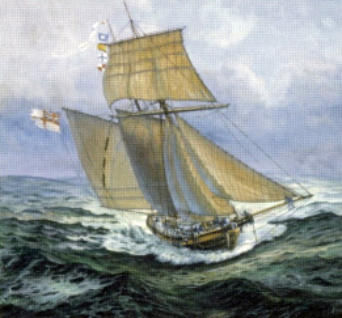
Current Situation
In 1996 a replica of the schooner Pickle was rebuilt in St Petersburg, Russia, using the
Russian ship Alevtina & Tuy as a basis, and took part in bicentenary anniversary
celebrations of the Battle of Trafalgar in 2005. She was subsequently used in the
filming of the BBC Four series Boats that Built Britain.
In 2014 the replica schooner was bought by MNABC member Mal Nicholson and is
currently moored in Ocean Village in Gibraltar undergoing repairs.
Previous owner Robin James, whose family had owned Pickle for the past nine years,
said “the decision to sell Pickle has been made far easier by finding Mal, who I trust to
continue to care for her and get her sailing again, while continuing to share her with
everybody from her past, present and future.”
For information see the Pickle facebook page, where he will post information on future
plans for the vessel, and will be re-developing the website www.schoonerpickle.com.
(note that currently the website still pertains to the old role of Pickle which no longer
applies)


Astrid was a dual-masted, square-rigged, iron/steel-hulled tall ship.
She
was 42-metre (138 ft) in length, with a 7-metre (23 ft) beam, a 2.7-metre
(8.9 ft) draught and a mast height of 25 metres (82 ft).
In addition to her
sails, she also had a small 253-kilowatt (339 hp) Scania Ds 1402 four-
stroke diesel motor for propulsion
Astrid had two deckhouses: one at the stern with navigational equipment
and maps, and another forward containing a bar. The lower deck had
twelve 2-person cabins (of which three could be used as 3-person cabins)
as well as showers, toilets and a galley.
Astrid was built in 1918 in Scheveningen, Netherlands by G van Leeuwen
as W.U.T.A., short for Wacht Uw Tijd Af meaning "Bide Your Time". She
was originally rigged as a lugger.
By 1930, she had been re-rigged as an
auxiliary schooner. Then owned by N. Müller, her port of registry was
Dordrecht, South Holland and her Code Letters were QOSF.
In 1934, her
Code Letters were changed to PIRV.
[13]
In 1937, Astrid (then known as W.U.T.A.) was sold to Swede J. Jeppson
and renamed Astrid. Her port of registry was changed to Skillinge and the
Code Letters SLEK were allocated. By this time, she had been derigged and was operating on her engine alone.
Astrid was used on
trade routes in the North Sea and Baltic Sea until 1975.
Astrid then sailed under a Lebanese flag.
She was allegedly used for drug
smuggling, and was being shadowed in the English Channel by HM Customs and Excise when she mysteriously caught fire.
Astrid
was found abandoned and burnt to a shell off the coast of England in the early 1980s.
Astrid was transferred to British ownership in 1984 when she was overhauled for the Astrid Trust, a private company limited by
guarantee.
She was subsequently dedicated on 17 May 1989 by Princess Anne, following which she took part in the 800th
anniversary celebrations of the Lord Mayor of London.
Astrid competed in the 1989,1990 and 1991 Cutty Sark Tall Ships' Races.
Astrid made more than 16 crossings of the Atlantic Ocean as a training ship.
Astrid was captained by Paul Compton until 1999.
In December 1996, the Astrid Trust was wound up, and Astrid, then lying in
Barbados, was put up for sale with an asking price of £750,000. Following her sale in 1997, Astrid was converted into a luxury sailing
vessel, after which she could carry 45 passengers, or have 24 guest crew members.
Since circa 2006, she had been owned by Ineke
and Pieter de Kam.
Astrid was a regular participant, and winner of several prizes, in Tall Ship Races and Regattas.
Astrid was based
in Weymouth Harbour, and was informally known as "Weymouth's vessel".
Astrid departed from Southampton, UK on 14 July 2013 and was due to arrive in Cherbourg, Seine-Maritime, France on 28 July 2013
as part of a European Union International Exchange program.
As of 14:00 on 23 July 2013, the ship was anchored in Oysterhaven
Anchorage in County Cork. The 30 crew members of the ship consisted of the master; three permanent crew members; a cook on a
temporary contract; a mentor and 24 trainees aged from 15-24 (eight from Ireland, four from the Netherlands, three from the United
Kingdom, six from France, two from Belgium and one from Spain. Pieter de Kam was captaining the ship.
The Astrid raised its anchor at around 11:00 on 24 July 2013, and left Oysterhaven on motor power.
She was one of 50 vessels
participating in Ireland's 2013 Gathering Cruise between Oysterhaven and Kinsale. At around 11:35 her sails were being raised while
the engine was still in use, and the ship was sailing towards the south-west at around 3 knots. At around 11:40, the ship's engine
failed.
Around midday on 24 July 2013, Astrid ran aground on Quay Rock at Ballymacus
Point, near the Sovereign Islands in southern Ireland, while attempting to enter
the harbour near Kinsale, County Cork.
The ship's engine failure prevented her
from pulling herself off the rocks.
The thirty crew members were rescued from the
tall ship, with 18 being rescued by a RNLI lifeboat and the other 12 by another tall
ship. Four RNLI lifeboats and two Irish Coast Guard helicopters were involved in
the rescue.
The incident was filmed by the Irish Coast Guard.
None of the crew
suffered any injuries.
The entire hull of the vessel was covered by water, with a 200-metre (660 ft)
exclusion zone being enforced by the patrol ship LÉ Róisín.
On 26 July, divers
and a surveyor started assessing whether salvage and repair of the ship would
be possible.
Initial reports indicated that Astrid had been looted overnight from
26–27 July, with the ship's wheel and heavy brass compass and bell stolen from the ship. However, it soon emerged that some of
items were missing from the ship within hours of the incident; subsequent news reports stated that the wheel was likely ripped off the
ship by the sea within 48 hours of the accident, and the Irish Coastguard and Naval Service issued a warning to stay away from the
wreck.
Salvage divers recovered all three missing items from the ship on 9 August, and they were handed over to the ship's owner.
A
video showing their recovery, and the damage to the ship, was later released.
Extensive damage was found by the diver's preliminary examination of the ship, including an inch-sized gaps in Astrid 's hull, as well
as popped rivets and spread plates.
The salvage company Blue Ocean, of
Castletownbere, were appointed to recover the ship.
The plans for the salvage
operation consisted of removing around 3.5 tonnes of diesel fuel from the ship's
fuel tanks, pumping water out of the ship and cutting away equipment including
the rigging and masts, before a floating crane lifted the vessel from the rocks.
The ship would then be taken to a nearby port to be handed over to the insurers.
As of the end of July 2013 it was thought that the ship will never sail again, and
that she would be written off as a total constructive loss.
A month after sinking,
Astrid was still under water.
Plans for the salvage operation were approved by the Irish Coast Guard and the
salvage operation began on 1 September, with work to remove loose ropes and
secure the fuel containers. The salvage operation was expected to take up to 3
weeks.
Astrid was recovered by the sheerleg GPS Atlas on 9 September 2013
by Atlantic Towage and Marine, and was transported on a barge to Kinsale for assessment and an investigation of what caused the
accident.
The insurers of the ship deemed the cost of restoring Astrid to be too high due to the damage caused while she was
partially submerged (an economic write-off); as such she was scrapped and taken to Cork Harbour to be broken up.
The scrapping
process was completed by April 2014.
[4][49]
On 23 July 2014, a day before the anniversary of the Astrid's sinking, an interim announcement from the Marine Casualty
Investigation Board (MCIB) said that the loss was due to engine failure, and that a full report would be posted once standard
procedure to ensure "natural justice" had been followed.
[27]
They rated the type of incident as a "Very Serious Marine Casualty".
[5]
On
the same day, it was reported that some of the canvas sails from the Astrid, as well as some of the timber from the lifeboats, had been
turned into designer handbags.
The MCIB released their full report on 11 February 2015. The report found that the main cause of the incident was that the ship had
not been operated safely in compliance with international conventions, and that the direct cause of the ship's grounding was due to
engine failure as a result of fresh water contamination of the engine's fuel, which occurred by human error when the water was taken
on board in Brighton on the 12th July 2013. It found a "catalogue of failures and breaches of international regulations", including
unsafe route planning that was influenced by photo opportunities rather than following the safest route, recommending that the master
of the ship should always have authority to override courses during promotional activities to ensure the safety of the ship and its crew
and passengers. It found that the SOLAS Conventions had been breached, and that the ship had not been certified as a passenger
ship for either EU or international voyages, that the crew were not appropriately certified, and that the ship should not have been at
sea. The liferafts were three months overdue of inspection, the Certificate of Seaworthiness was invalid and the master's Certificate
of Competency had expired a month before the accident. It also noted that mistakes were made with the mayday alert, causing a 10-
minute delay in deploying the RNLI and Coast Guard, which could have had a significant impact if the conditions of the incident had
been worse. The ship's owners were financially ruined by the incident.

Astrid in 2013, Weymouth Bay


The full investigation report into the loss of the Astrid can be read HERE
Built in 1948 in Le Havre, France, Pelican was originally a double-beam Arctic fishing
trawler,
[2]
one of five identical ships built in Chantiers et Ateliers, the shipyard once
owned by the shipbuilder Augustin Normand. She was sold to a Norwegian firm and
spent the next 19 years fishing the Arctic.
In 1968 Pelican was reclassified from a trawler to a coaster. Her owners renamed her
Kadett. She remained Kadett for 27 years until in 1995 she again changed hands.
She was bought by ex-Naval Commander Graham Neilson who transformed her into
a tall ship. He had already undertaken a similar project with the TS Astrid. Working
in Portland Harbour, Dorset, UK, Neilson and his team spent 12 years stripping back
the trawler and rebuilding her as a main mast barquentine. A trainee on the ship won
the 2010 Torbay cup
As of 2012, Pelican has operated as a sail training vessel for young people, by the charity Adventure Under Sail. Sail Training
International ranks it as a Class A tall ship
Pelican of London was last advertised for sale in 2012, valued at £2.45 million.
The sailing ship Pelican of London that was built at Portland Port by Cdr Graham Neilson RN has left its former home port over the
weekend for a special military mission for the Royal Navy. It is heading down to Gibraltar and then to the Mediterranean with a party
of young Royal Navy Officers and Royal Fleet Auxiliary Cadets to literally learn the ropes.
Many Navy services around the world have their own sail training ships and this training role for The Pelican could be almost a lifeline
too.
Captain Callum Mc Ardell, himself a former RFA officer, was delighted to be selected to take part in this unique programme for the
Royal Navy. Plus, at a local level, also pleased to bring the ship into Portland yet again where it was built as the ship’s UK base is
Barrow In Furness. He said: “We are here to collect a party of young Navy officers and RFA cadets and to embark stores for the four-
month training tour around the Mediterranean. We will be teaching 21st century sailors vital 19th century maritime techniques like
climbing the rigging and steering on the exterior housed wheel. These are all skills that we are very good at teaching. As this is a very
manual ship it’s also a career-building step too. Portland for us is an excellent base for loading all the stores and bunkering. Plus its
the place where she was converted into a sail training ship.”
With fewer places currently on Naval ships for continuation training within the Fleet they are using the sailing ship to enhance and
develop the young officers’ maritime experiences and skills. This covers seamanship, navigation and watch keeping duties, using
sextants and being able to work with just manual maritime skills. In order to progress the trainees will need to have logged some
several hundred hours of experience across all of those disciplines.
Providing this unique maritime training service to the Royal Navy has given The Pelican a chance to receive a vital financial boost in
these cash-strapped times. Having to normally survive on civilian sail training experiences for the public, this new longer-term income
appears to be a game changer for the future of the ship.
Callum, a Dorset based Captain, will be taking the ship in a few days across the Bay of Biscay down to Gibraltar, something he
admitted is always a challenge.
He added: "A 26,000 ton RFA that can plough through the waves is one thing but a 45-metre sailing ship really does focus the mind,
not to mention the stomach. Even I am not totally immune from seasickness and working around that is another lesson to be taught
to the trainees too.”
Pelican of London was built by former Royal Navy Commander, Graham Neilson, who converted the basic metal hull into a splendid
three-masted barque in the 1990s

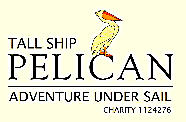


HISTORIC SHIPS

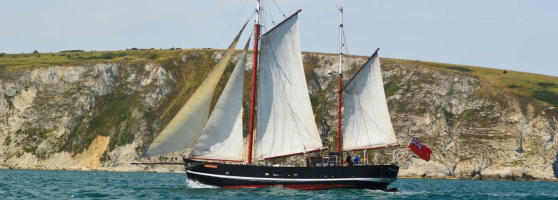

Weymouth and Portland is set to have a very special visitor in time for the summer 2018 as the tall ship Moonfleet has made Portland
Marina her new home. She is available for sailing trips from Portland, visiting stunning locations along Dorset’s Jurassic Coastline,
including Weymouth Bay, Durdle Door, Lulworth Cove, Mupe, Worbarrow Bay and Chapman’s Pool.
Trips vary from a one hour sunset trip around Portland, right up to a six hour Jurassic Coast explorer to Chapman’s Pool and back.
This is a unique opportunity to explore and enjoy the Jurassic Coast from the sea, no previous sailing experience is needed.
With the departure of tall ship Pelican earlier in the year, Moonfleet is now Dorset’s only tall ship. Jez Hallett, Skipper at Moonfleet
Adventure Sailing, says: “Sailing on Moonfleet is a ‘toe in the water’ participation event. We encourage passengers to get involved
with sailing under our supervision, whether it be taking the wheel to steer, pulling on ropes, or helping with sail handling. It’s a great
day out. However, For those who would prefer to put their feet up and take in the beautiful scenery that Weymouth and the Dorset
coast have to offer, the option is there to sit back, relax and watch the world go by.”
Originally built in Holland in 1930, Moonfleet is a magnificent steel-hulled Gaff Cutter. She began her life as a cargo vessel. At the
turn of the last century she was converted into a sail training vessel, operating out of Amsterdam.
Moonfleet Adventure Sailing was founded in 2015 following the ship’s relocation to the UK, including a refit on the River Tamar. She is
now used for day sailing, educational trips, parties and corporate events.
More details at: www.moonfleetsailing.com
HISTORIC SHIPS

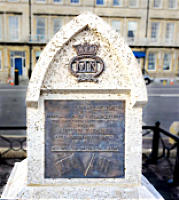
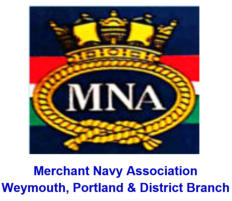


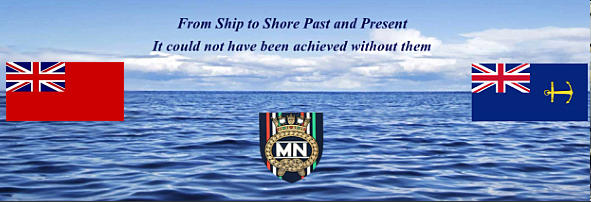
2025 - A New Role With the Royal Navy
